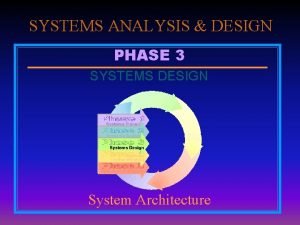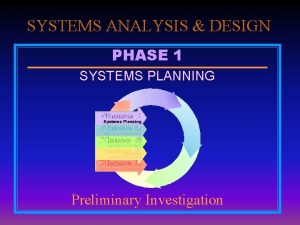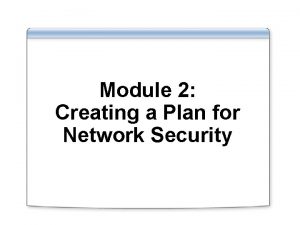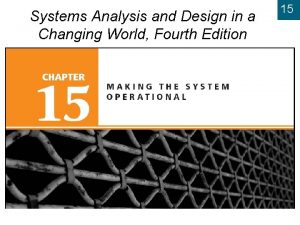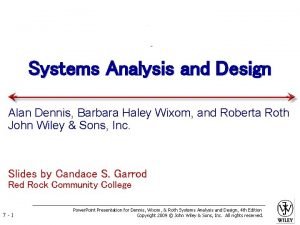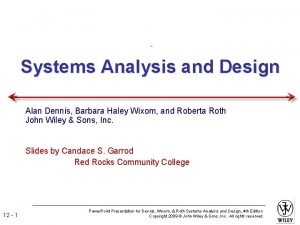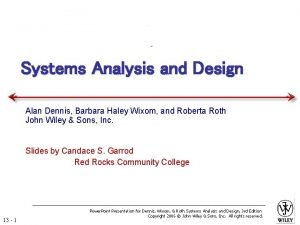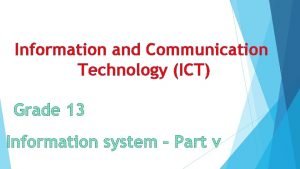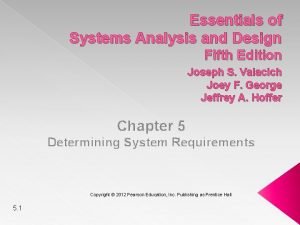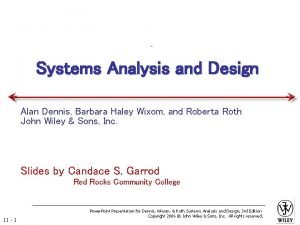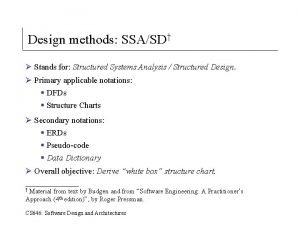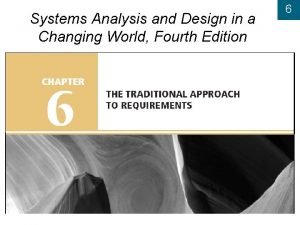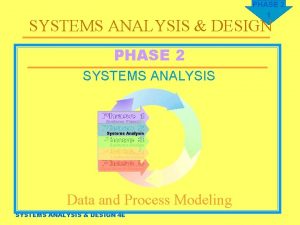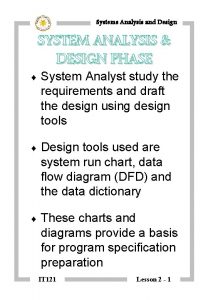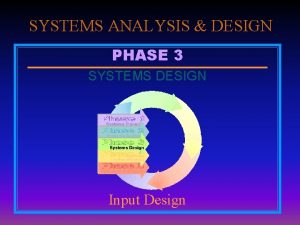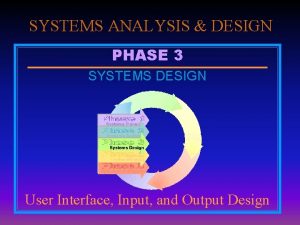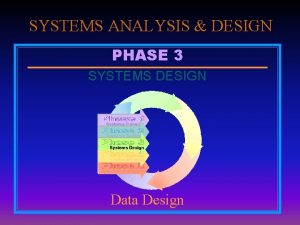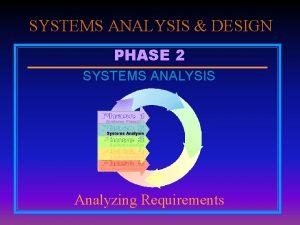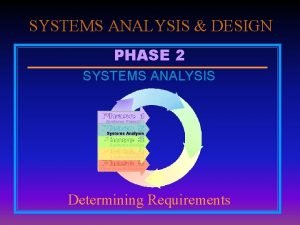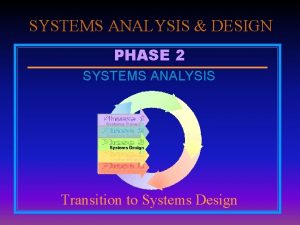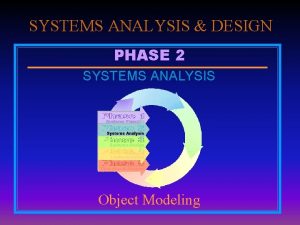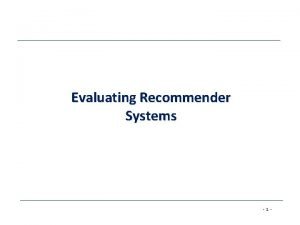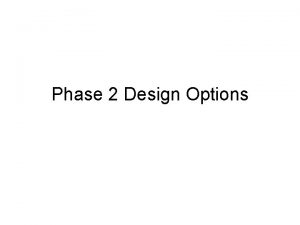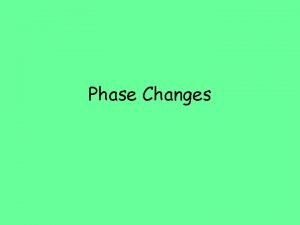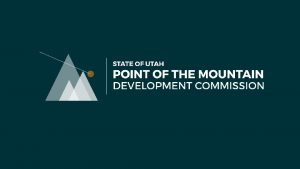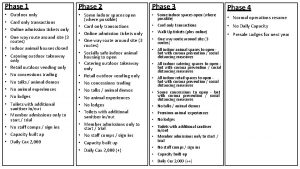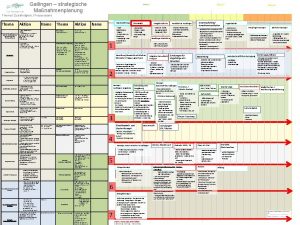SYSTEMS ANALYSIS DESIGN PHASE 2 SYSTEMS ANALYSIS Evaluating




















































- Slides: 52

SYSTEMS ANALYSIS & DESIGN PHASE 2 SYSTEMS ANALYSIS Evaluating Alternatives and Strategies

Chapter 5 Evaluating Alternatives and Strategies SYSTEMS ANALYSIS & DESIGN 3 E PHASE 2 2

Objectives PHASE 2 3 à Evaluate various alternatives when planning systems development and acquisition à Explain the advantages and disadvantages of in-house development versus purchasing a software package à List the steps in purchasing and evaluating a software package SYSTEMS ANALYSIS & DESIGN 3 E

Objectives PHASE 2 4 à Explain the differences between a request for proposal (RFP) and a request for quotation (RFQ) à Describe the contents of the system requirements document and explain its purpose à Explain the prototyping process and describe a typical situation where prototyping is used SYSTEMS ANALYSIS & DESIGN 3 E

Objectives PHASE 2 5 à Describe computer-aided software engineering (CASE) tools and explain how they are used during the systems development life cycle à Explain how systems flowcharts and statetransition diagrams are used SYSTEMS ANALYSIS & DESIGN 3 E

Introduction PHASE 2 6 à Chapter 5 covers the remaining tasks in the systems analysis phase à Evaluation of alternative solutions à Preparation of the system requirements document à Presentation to management SYSTEMS ANALYSIS & DESIGN 3 E

Evaluating Software Alternatives à Make or buy decision à In-house software à Developed by the company’s IS department à Software package à Purchased or leased from software publishers or vendors à Horizontal application à Vertical application SYSTEMS ANALYSIS & DESIGN 3 E Click to see Figure 5 -1 PHASE 2 7

Evaluating Software Alternatives PHASE 2 8 à Developing software in-house à Reasons for in-house development à Satisfy unique requirements à Minimize changes in business procedures and policies à Meet constraints of existing systems à Meet constraints of existing technology à Develop internal resources and capabilities SYSTEMS ANALYSIS & DESIGN 3 E Click to see Figure 5 -2

Evaluating Software Alternatives PHASE 2 9 à Buying a software package à Reasons for buying a software package à Lower costs à Requires less time to implement à Proven reliability and performance benchmarks à Implemented by other companies à Requires less technical development staff à Future upgrades provided by the vendor SYSTEMS ANALYSIS & DESIGN 3 E Click to see Figure 5 -2

Evaluating Software Alternatives PHASE 2 10 à Customizing software packages à Purchase a basic package that can be customized to suit your needs à Negotiate with software vendor to make enhancements to suit your needs à Purchase the package and make your own modifications SYSTEMS ANALYSIS & DESIGN 3 E

Evaluating Software Alternatives à Other software alternatives à Outsourcing à End-user systems à Enterprise computing SYSTEMS ANALYSIS & DESIGN 3 E PHASE 2 11

Evaluating Software Alternatives PHASE 2 12 à Outsourcing à Using outside companies to handle part of the workload, on short-term or long-term basis à Contract personnel firms à Systems management or facilities management firms SYSTEMS ANALYSIS & DESIGN 3 E

Evaluating Software Alternatives PHASE 2 13 à End-user systems à Major factor in systems planning and development à Applications can be managed by end-users SYSTEMS ANALYSIS & DESIGN 3 E Click to see Figure 5 -3

Evaluating Software Alternatives PHASE 2 14 à End-user systems à Major factor in systems planning and development à Applications can be managed by end-users à Software suites offer integrated applications à Interactive Help features include wizards à Security concerns might require read-only files à Information centers (IC) can support enduser systems SYSTEMS ANALYSIS & DESIGN 3 E Click to see Figure 5 -4

Evaluating Software Alternatives PHASE 2 15 à Enterprise computing à Overall information management strategy à Key is effective integration of information resources à Many systems involve client/server architecture SYSTEMS ANALYSIS & DESIGN 3 E

Evaluating Software Alternatives PHASE 2 16 à Selecting a software alternative à Decision will affect remaining SDLC phases à Systems analyst’s involvement depends on which alternative is selected SYSTEMS ANALYSIS & DESIGN 3 E Click to see Figure 5 -5

Steps in Evaluating and Purchasing Software Packages PHASE 2 17 à Five step process 1. Evaluate the information system requirements 2. Identify potential software vendors 3. Evaluate software package alternatives 4. Make the purchase 5. Install the software package SYSTEMS ANALYSIS & DESIGN 3 E

Steps in Evaluating and Purchasing Software Packages PHASE 2 18 Step 1: evaluate the information system requirements à Identify the key features of the system à Estimate volume and future growth à Specify any hardware constraints à Prepare a request for proposal or quotation SYSTEMS ANALYSIS & DESIGN 3 E Click to see Figure 5 -6

Steps in Evaluating and Purchasing Software Packages PHASE 2 19 Step 2: identify potential software vendors à Next step is to contact potential vendors à An RFP will help vendors to identify solutions à Various sources of information on suppliers à Retailers à Computer manufacturers à Industry trade journals à Systems consultants SYSTEMS ANALYSIS & DESIGN 3 E Click to see Figure 5 -7

Steps in Evaluating and Purchasing Software Packages PHASE 2 20 Step 3: evaluate software package alternatives à Object is to compare software packages and select the best alternative à Obtain information from many sources à Vendor presentations and literature SYSTEMS ANALYSIS & DESIGN 3 E Click to see Figure 5 -8

Steps in Evaluating and Purchasing Software Packages PHASE 2 21 Step 3: evaluate software package alternatives à Object is to compare software packages and select the best alternative à Obtain information from many sources à Vendor presentations and literature à Product documentation à Trade publications à Companies that perform software testing/evaluation SYSTEMS ANALYSIS & DESIGN 3 E Click to see Figure 5 -9

Steps in Evaluating and Purchasing Software Packages PHASE 2 22 Step 3: evaluate software package alternatives à Object is to compare software packages and select the best alternative à Obtain information from many sources à Vendor presentations and literature à Product documentation à Trade publications à Companies that perform software testing/evaluation à Contact users of the package Click to see Figure 5 -10 a à Benchmark test SYSTEMS ANALYSIS & DESIGN 3 E Click to see Figure 5 -10 b

Steps in Evaluating and Purchasing Software Packages Step 4: make the purchase à Software licenses à Lease agreements à Maintenance agreements SYSTEMS ANALYSIS & DESIGN 3 E PHASE 2 23

Steps in Evaluating and Purchasing Software Packages Step 5: install the software package à Installation time depends on size and complexity à Before using the package, complete all implementation steps à Loading, configuring, and testing the software à Training users à Converting data files to new format SYSTEMS ANALYSIS & DESIGN 3 E PHASE 2 24

PHASE 2 25 Hardware Alternatives à Hardware decisions use the same five-step approach as software decisions à Evaluate system requirements à Identify potential hardware vendors à Evaluate hardware alternatives à Make the purchase à Install the hardware SYSTEMS ANALYSIS & DESIGN 3 E Click to see Figure 5 -11

Hardware Alternatives PHASE 2 26 à Other issues to consider à Turnkey systems à Site preparation à New workstations à Network cabling à Raised floors à Conditioned electrical lines à Fire extinguishing equipment à Uninterruptible power supplies (UPSs) SYSTEMS ANALYSIS & DESIGN 3 E

TRADEOFF PHASE 2 27 à How do you select the best alternative? à Most companies combine à In-house developed software à Software packages à Outsourcing à End-user systems à Object is to develop a list of viable alternatives à All viable alternatives must be evaluated à Feedback from users is essential SYSTEMS ANALYSIS & DESIGN 3 E

A KEY QUESTION PHASE 2 28 à How will you prepare for the meeting with Doug Sawyer? à What is your strategy and how will you present your alternatives? à Consider the pros and cons of in-house development vs. purchase of a package SYSTEMS ANALYSIS & DESIGN 3 E

Completion of Systems Analysis PHASE 2 29 à System requirements document à Also called software requirements specification à Describes alternatives and makes recommendation to management à Similar to a contract for what will be delivered à Must be clear and understandable to users SYSTEMS ANALYSIS & DESIGN 3 E

Completion of Systems Analysis PHASE 2 30 à Presentation to management à Five probable management decisions 1. Develop an in-house system 2. Modify the current system 3. Purchase or customize a software package 4. Perform additional systems analysis work 5. Stop all further work SYSTEMS ANALYSIS & DESIGN 3 E

Completion of Systems Analysis PHASE 2 31 à Presentation guidelines and suggestions à Give overview of the project’s purpose and objectives à Summarize alternatives, with costs, pros, and cons à Explain why the recommended alternative was chosen à Allow time for discussion, questions, and answers à Obtain final decision from management or timetable for next step SYSTEMS ANALYSIS & DESIGN 3 E

Prototyping PHASE 2 32 à A prototype is an early, rapidly constructed working version of the system à A working model helps users understand the system à Prototyping produces a less-expensive model à Can eliminate problems before the final version SYSTEMS ANALYSIS & DESIGN 3 E

Prototyping PHASE 2 33 à Prototyping software tools à Nonprocedural tools specify the problem to be solved, rather than how to solve it à Fourth-generation environment prototyping tools à CASE toolkit SYSTEMS ANALYSIS & DESIGN 3 E Click to see Figure 5 -12

Prototyping PHASE 2 34 à Prototyping software tools à Nonprocedural tools specify the problem to be solved, rather than how to solve it à Fourth-generation environment prototyping tools à CASE toolkit à Report writer or report generator SYSTEMS ANALYSIS & DESIGN 3 E Click to see Figure 5 -13

Prototyping PHASE 2 35 à Fourth-generation environment prototyping tools à CASE toolkit à Report writer or report generator à Query language à Screen generator, screen painter, screen mapper, or form generator à Program generator or code generator à Fourth-generation language (4 GL) Click to see Figure 5 -14 a SYSTEMS ANALYSIS & DESIGN 3 E Click to see Figure 5 -14 b

PHASE 2 36 Prototyping à Prototyping during systems analysis à Goal is to develop a working model quickly à Early way to test essential system features à Prototype can be upgraded or replaced during later SDLC phases SYSTEMS ANALYSIS & DESIGN 3 E Click to see Figure 5 -15

Computer-Aided Software Engineering (CASE) PHASE 2 37 à CASE tools increase productivity à Full set of CASE tools is called a toolkit à CASE tools can handle variety of tasks à Create and integrate data flow diagrams à Logical and physical design à Generation of program code à CASE tool example is Visible Analyst Click to see Figure 5 -16 SYSTEMS ANALYSIS & DESIGN 3 E Click to see Figure 5 -17

Computer-Aided Software Engineering (CASE) PHASE 2 38 à Categories of CASE tools à Diagramming tools SYSTEMS ANALYSIS & DESIGN 3 E Click to see Figure 5 -18

Computer-Aided Software Engineering (CASE) PHASE 2 39 à Categories of CASE tools à Diagramming tools à Prototyping tools à Central repository Click to see Figure 5 -19 a SYSTEMS ANALYSIS & DESIGN 3 E Click to see Figure 5 -19 b

Computer-Aided Software Engineering (CASE) PHASE 2 40 à Categories of CASE tools à Diagramming tools à Prototyping tools à Central repository à Data design tools à Project management tools à Maintenance tools à Another CASE example: Hyper Analysis Toolkit (HAT) SYSTEMS ANALYSIS & DESIGN 3 E Click to see Figure 5 -20

Computer-Aided Software Engineering (CASE) PHASE 2 41 à Using CASE tools à Data design tool à Programming tool à Program debugger à Code generator à Project management tool à Maintenance tool Click to see Figure 5 -21 a SYSTEMS ANALYSIS & DESIGN 3 E Click to see Figure 5 -21 b

Computer-Aided Software Engineering (CASE) PHASE 2 42 à Categories of tools à Forward engineering tools (used during SDLC work) à Reverse engineering tools (convert program code into design specifications) à Reengineering toolkit (uses reverse and forward engineering) à Front-end, or upper-CASE tools (used in first three SDLC phases) à Back-end, or lower-CASE tools (used during systems implementation and operation phases) SYSTEMS ANALYSIS & DESIGN 3 E

TRADEOFF PHASE 2 43 à Pros and cons of CASE tools à Advantages à Automate manual tasks à Encourage standard methods à Improve accuracy and overall quality of end product SYSTEMS ANALYSIS & DESIGN 3 E

TRADEOFF PHASE 2 44 à Disadvantages à Cost of CASE software and hardware needed à Lack of CASE standards à Other issues à CASE does not replace need for analyst’s skills à Initial preparation effort not always worthwhile SYSTEMS ANALYSIS & DESIGN 3 E

A KEY QUESTION PHASE 2 45 à Does the new CASE toolkit at Sunnyside Beverages replace the need to teach new analysts how to create DFDs? à How would you respond? SYSTEMS ANALYSIS & DESIGN 3 E

Alternative Graphical Tools PHASE 2 46 à Other tools can be used in addition to DFDs à Systems flowcharts à State-transition diagrams SYSTEMS ANALYSIS & DESIGN 3 E

Alternative Graphical Tools PHASE 2 47 à Systems flowcharts à Display major process, input, and output operations à Primarily used in physical modeling à Various symbols represent data or files in specific physical media à Shape of symbol indicates the purpose à Lines with arrowheads indicate the flow of data SYSTEMS ANALYSIS & DESIGN 3 E Click to see Figure 5 -22

Alternative Graphical Tools PHASE 2 48 à State-transition diagrams à Show time sequence of real-time systems à A real-time system processes data and feeds it back to the system à Real-time system examples à Automobile cruise control systems à Microprocessor-controlled thermostats à Microwave oven control system Click to see Figure 5 -23 SYSTEMS ANALYSIS & DESIGN 3 E Click to see Figure 5 -24

Transition to Systems Design PHASE 2 49 à Next SDLC phase is system design for inhouse system development à Size of the development team depends on the company and the nature of the project à System requirements document à An accurate and understandable document is essential à Document contains design for the new system à Must reflect thorough analysis and effective communication SYSTEMS ANALYSIS & DESIGN 3 E

SOFTWEAR, LIMITED PHASE 2 50 à Rick and Carla attend training workshop for SWL’s new CASE toolkit: Visible Analyst à The development team evaluates various alternatives and potential solutions à The IS department recommendations: 1. Purchase a commercial package for payroll functions from Pacific Software Solutions 2. Develop an ESIP system in-house to meet SWL’s unique requirements SYSTEMS ANALYSIS & DESIGN 3 E

SOFTWEAR, LIMITED PHASE 2 51 à Other tasks accomplished by Rick and Carla à Completed the logical model, alternative evaluations, and cost/time estimates à Prepared the system requirements document à Printed and distributed the document à Scheduled a presentation to management à Prepared and rehearsed the presentation à Developed visual aids à Tried to anticipate questions SYSTEMS ANALYSIS & DESIGN 3 E

SOFTWEAR, LIMITED PHASE 2 52 à Results of the presentation à Recommendation was approved à Top managers indicated support for the project à The next step à Negotiate a contract with Pacific Software Solutions for purchase of the payroll package à Begin systems design work for the ESIP system SYSTEMS ANALYSIS & DESIGN 3 E
 This is the final task in phase 3: systems design
This is the final task in phase 3: systems design This is the final task in phase 3: systems design
This is the final task in phase 3: systems design This is the final task in phase 3: systems design.
This is the final task in phase 3: systems design. This is the final task in phase 3 systems design
This is the final task in phase 3 systems design Normal phase vs reverse phase chromatography
Normal phase vs reverse phase chromatography M tswett pronunciation
M tswett pronunciation Mobile phase and stationary phase
Mobile phase and stationary phase Stationary phase in gas chromatography
Stationary phase in gas chromatography Normal phase vs reverse phase chromatography
Normal phase vs reverse phase chromatography Power formula three phase
Power formula three phase Adsorption chromatography
Adsorption chromatography In a triangle connected source feeding a y connected load
In a triangle connected source feeding a y connected load Csce 441
Csce 441 Four phase systems
Four phase systems Forward reference table frt is arranged like
Forward reference table frt is arranged like The distribution objective must be congruent with:
The distribution objective must be congruent with: Planning phase for network security design
Planning phase for network security design Systems analysis and design in an age of options pdf
Systems analysis and design in an age of options pdf Gantt chart in system analysis and design
Gantt chart in system analysis and design Systems analysis and design in a changing world
Systems analysis and design in a changing world Systems analysis and design in a changing world
Systems analysis and design in a changing world System analysis and design alan dennis
System analysis and design alan dennis Introduction of system analysis and design
Introduction of system analysis and design Structured systems analysis and design methodology
Structured systems analysis and design methodology Modern system analysis and design
Modern system analysis and design Modern systems analysis and design
Modern systems analysis and design Kendall and kendall system analysis and design
Kendall and kendall system analysis and design System analysis and design dennis
System analysis and design dennis Systems analysis and design alan dennis
Systems analysis and design alan dennis Systems analysis and design alan dennis
Systems analysis and design alan dennis Systems analysis and design alan dennis
Systems analysis and design alan dennis Systems analysis and design alan dennis
Systems analysis and design alan dennis Systems analysis and design alan dennis
Systems analysis and design alan dennis Systems analysis and design alan dennis
Systems analysis and design alan dennis Ssadm diagram
Ssadm diagram Radar systems analysis and design using matlab
Radar systems analysis and design using matlab Object-oriented systems analysis and design using uml
Object-oriented systems analysis and design using uml A modern approach to systems analysis and design
A modern approach to systems analysis and design Patched-up prototype
Patched-up prototype Kendall and kendall terminology
Kendall and kendall terminology System analysis and design in a changing world
System analysis and design in a changing world Systems analysis and design in a changing world
Systems analysis and design in a changing world Systems analysis and design in a changing world
Systems analysis and design in a changing world Systems analysis and design alan dennis
Systems analysis and design alan dennis Systems analysis and design alan dennis
Systems analysis and design alan dennis Systems analysis and design alan dennis
Systems analysis and design alan dennis Modern systems analysis and design 7th edition
Modern systems analysis and design 7th edition Ssadm
Ssadm Essentials of systems analysis and design
Essentials of systems analysis and design Systems analysis and design in a changing world
Systems analysis and design in a changing world Systems analysis and design alan dennis
Systems analysis and design alan dennis List the five basic steps of ssa/sd process
List the five basic steps of ssa/sd process Systems analysis and design in a changing world
Systems analysis and design in a changing world
